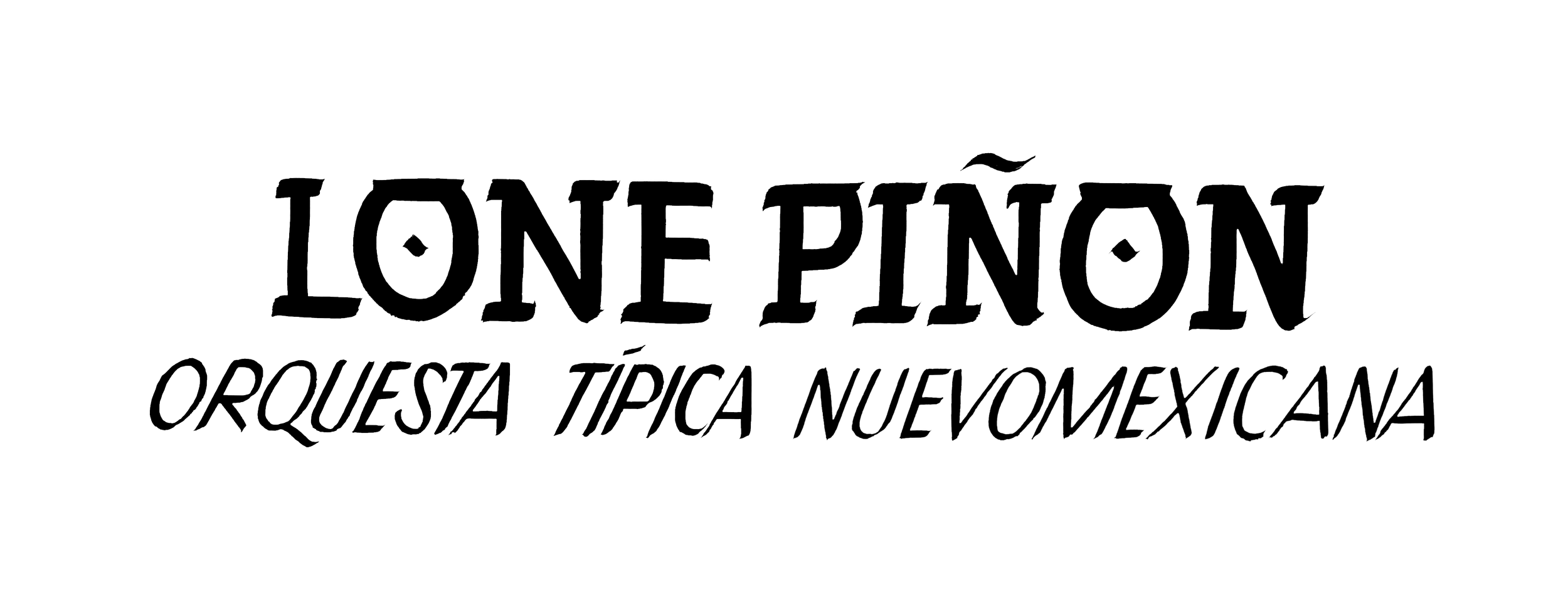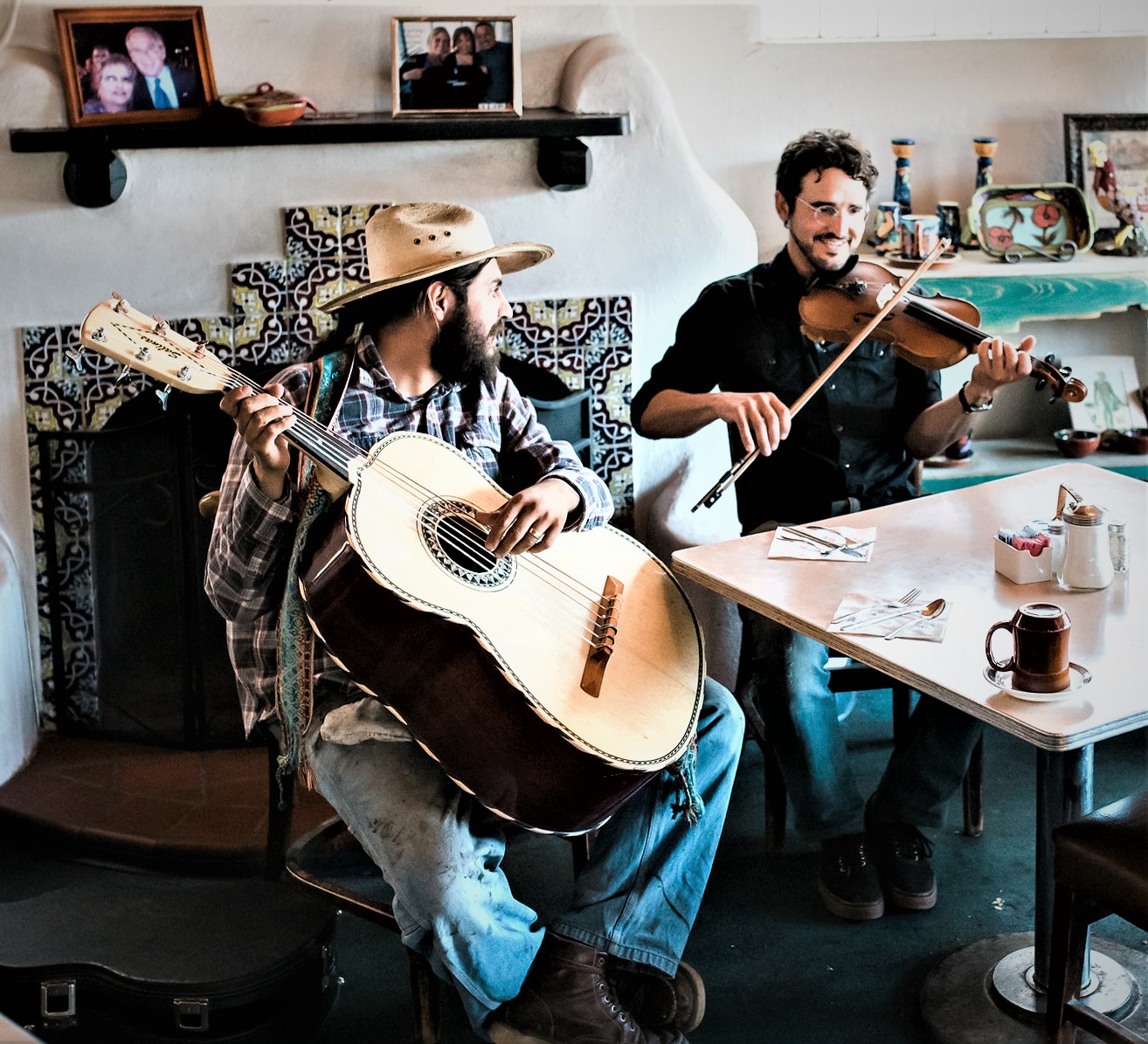Songs of Our Elders
Photo by Stacey M Adams
By Molly Boyle for Pasatiempo, April 3, 2019
You might be able to tell a lot about a band by where they eat on the road. Jordan Wax called Pasatiempo from the Panza Hueca Lonchería, where he and Noah Martinez were refueling on huaraches and burritos after a gig at the El Paso Museum of Art.
It stands to reason that Lone Piñon’s lunch would match the musicians’ tireless pursuit of borderland authenticity. For the past five years, Wax, thirty-seven, and Martinez, twenty-nine, have been researching and re-creating the oldest string music of New Mexico. With recent gigs at the Kennedy Center’s Millennium Stage and the Library of Congress in Washington, D.C., along with their marquee billing at Gov. Michelle Lujan Grisham’s inauguration, Lone Piñon has risen to prominence as a conjunto, or a small musical group, that plays the real deal when it comes to traditional norteño music.
Bassist and frequent collaborator Tanya Nuñez joins the two at the heritage music celebration concert Nuestra Música on Saturday, April 6, at the Lensic Performing Arts Center.
The “Chicano string band,” as Martinez has described them, is guided by their sense of musicianship: They not only respect the elder practitioners of these musical forms, they are determined to ensure that the old songs are not forgotten. Wax sings traditional songs in English, Spanish, Nahuatl, and even Purépecha, an indigenous tongue from Michoacán, Mexico. He’s traveled to Michoacán and the Huasteca region of San Luis Potosí to immerse himself in the study of Mexican huapango fiddling, seeking out noted fiddlers as mentors. Both Martinez and Wax play an array of instruments, breathing new life into the kind of music that was once played all over the state: chotes, polkas, huapangos, son calentano, and regular old northern Mexico conjunto music.
At first glance, Wax and Martinez are an odd couple. Wax, a Jewish fiddler from Missouri who moved to the state in 2012, met the North Valley-born bassist Martinez and original Lone Piñon guitarist Greg Glassman in 2014 at an Albuquerque coffee shop.
“What l liked about Jordan was that he was doing a lot of the old-style songs that I had heard in the Onda Chicana style,” Martinez said, describing the style of 1960s and ’70s bands playing traditional Mexican music and adding rock ’n’ roll, R&B, and even jazz arrangements. “But they were the same kind of old tunes. Jordan really had a connection to the roots of the old fiddle traditional styles.”
Over their three albums, Lone Piñon has evolved from a trio to a duo with frequent guests. Their latest album, Dále Vuelo, dropped in March with 14 tight, sprightly dance tunes that might have been played in the Plaza when New Mexico was Mexico. Dále Vuelo marks the first time the two have recorded with the instruments originally used to compose and play the songs they’ve chosen. The album’s huapangos are played with the huapanguera and jarana huasteca, guitar-like instruments that originated the sound. Martinez said, “This was an opportunity for us to represent the genres we’ve been learning and playing, but with more authentic instrumentation and different added voices.”
The call-and-response quality of Wax and Martinez’s conversational rhythms mimics their musical partnership. “There’s definitely different styles of singing for the different styles of music on there,” Wax said, describing how he’s learned to adapt his singing voice. “The huapango style is really unique. The falsetto is a really important part, like a particular style of falsetto.” On other tunes, he said, he sings in “a more northern Mexico style. There’s a particular style of low vibrato. And also just the phrasing and the tone, you know, it’s a little ...” he said, faltering.
Martinez jumped in. “That style of music is really ranchera-y, you know. Those guys had that voice of working all the time. It’s not rough so much as heartfelt, very from the soul.”
The band frequently mentions their debt to elder musicians. Wax singled out the track “Juárez,” which appropriates an arrangement from famed Tejano accordionist Flaco Jimenez. Martinez said his playing on the album was mainly inspired by bass player Pedro Garza, who played in the Onda Chicana style. “He actually passed away the day we recorded the pasodoble [“Pasodoble el Hidalguense,” the album’s second song] and I was thinking about him, so in that song I played a lot of his kind of licks on guitarrón.” Chicago son jarocho musician Juan Rivera gave them lessons in huapango that included listening to 50-year-old recordings of Rivera’s uncle’s arrangements, which sparked at least one track on Dále Vuelo.
This is the third year Lone Piñon plays Nuestra Música, and many of the band’s regional musical heroes and mentors are on the same bill. Wax has been sitting in on sessions with ninety-five-year-old accordion legend Antonia Apodaca for years. “I had a chance to start learning her style of accordion music on the two-row accordion,” he said.
“Roberto Mondragón is a hero of ours, too,” Martinez said of another longtime Nuestra Música headliner, the former lieutenant governor, activist, and singer-songwriter. And Northern New Mexico guitarist Cipriano Vigil is “amazing and has contributed so much. He knows so much about all the different song traditions. I’ve learned so much from listening to him and reading the stuff he’s written.” Lone Piñon has also played with La Sociedad Colonial Español de Santa Fe, which performs folklórico dances at the Nuestra Música event. “They’ve been generous in sharing what they know about the dancing,” Martinez said. “I was going for a while each week to their dance practices and trying to learn the kind of dances that they do. That kind of inspired us to do a dance series.” The band frequently books bailes in Santa Fe and Albuquerque, where a dance instructor comes to teach audience members how to do a traditional dance with live Lone Piñon accompaniment.
There is more around the corner for the rising sons of these musical traditions. This summer, Lone Piñon represents New Mexico at the Centrum Festival of American Fiddle Tunes in Port Townsend, Washington. A new documentary about the band by filmmaker Cody Edison, And Those Who Dance It Surrender Their Hearts to Each Other, is also currently premiering at festivals across the country. It follows Martinez and Wax’s mission to bring the old sounds back to New Mexico.
But at its core, Lone Piñon is just two dudes who, at the time of our talk, were eagerly awaiting their Mexican food so they could get to the next gig. The day after our conversation, the band was slated to play in both Madrid and Albuquerque.
“Definitely we get hired more now than before,” Martinez laughed.

